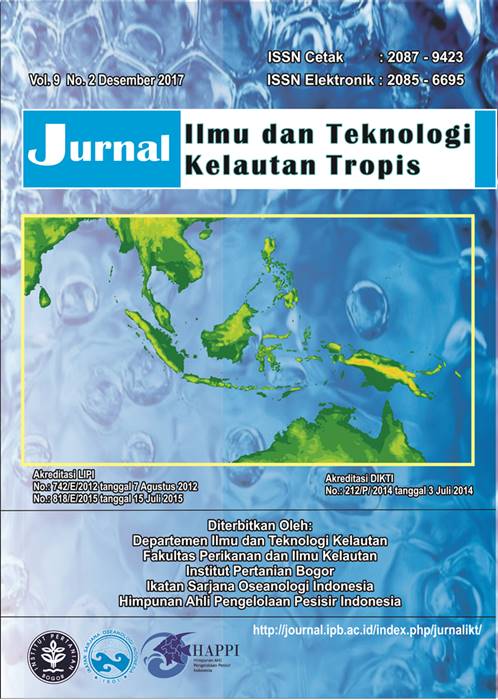CHARACTERISTICS AND VARIABILITY OF THE FLORES ITF AND ITS COHERENCE WITH THE SOUTH JAVA COASTAL CURRENT
Abstract
Characteristics and transport variability of the Indonesian Throughflow (ITF) in the western Flores Sea (FS) and its coherency with the South Java Coastal Current (SJCC) fluctuation are investigated using validated ocean general circulation model output (2008-2014) from the INDESO configuration. The results show that near-surface circulation in the study area is characterized by two distinct regimes: strong southwestward ITF flow and quasi-transient anti-cyclonic eddies. Vertical dimension of ITF crossing 7.5°S is about 112 km width, 250 m depth, and high velocity core at thermocline >0.3 m/s. Transport volume estimates along this latitude is -4.95 Sv (southward). Bifurcation of ITF flow appears north offshore Lombok Island where -2.92 Sv flowing into Lombok Strait and the rest flowing eastward into FS. Meanwhile, vertical dimension of SJCC crossing 114°E is about 89 km width, 120 m depth, and high velocity core at sub-surface >0.35 m/s. Mean transport of SJCC is +2.65 Sv. Coherency between Flores ITF and SJCC transport variability on intra-seasonal scales is significantly high, e.g., on 30 day period (coher=0.92) and phase-lags of 0.6-day with SJCC leading to Flores ITF. This result confirmed previous studies, related to intrusion of coastally trapped Kelvin waves into Flores Sea via Lombok Strait.
Keywords: Indonesian Throughflow, western Flores Sea, South Java Coastal Current
Authors
This work is licensed under a Creative Commons Attribution 4.0 International License.
Jurnal Ilmu dan Teknologi Kelautan Tropis i is an open-access journal, meaning that all content is freely available without charge to the user or their institution. Users are allowed to read, download, copy, distribute, print, search, or link to the full texts of the articles in this journal without needing to request prior permission from the publisher or the author.
All articles published by Jurnal Ilmu dan Teknologi Kelautan Tropis are licensed under the Creative Commons Attribution 4.0 International License. This allows for unrestricted use, distribution, and reproduction in any medium, provided proper credit is given to the original authors.
Authors submitting manuscripts should understand and agree that the copyright of published manuscripts is retained by the authors. Copyright encompasses the exclusive rights of authors to reproduce, distribute, and sell any part of the journal articles in all forms and media. Reproduction of any part of this journal, its storage in databases, and its transmission by any form or media is allowed without written permission from Jurnal Ilmu dan Teknologi Kelautan Tropis.


